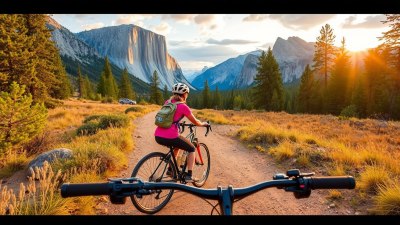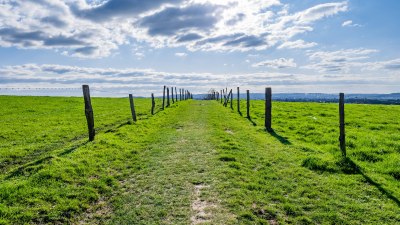Exploring National Parks by Bicycle: What You Need to Know
Discover essential tips and insights for biking in national parks for a thrilling adventure.

Image created with Flux Schnell
Exploring national parks by bicycle is an extraordinary way to experience nature's beauty while staying active. With stunning landscapes, diverse ecosystems, and well-maintained trails, national parks offer breathtaking scenery that can be best appreciated from the seat of a bike. Whether you are a seasoned cyclist or a beginner, biking in national parks can provide unforgettable memories and unique encounters with wildlife and nature. This guide will provide you with crucial information and tips to ensure your cycling adventure in national parks is safe, enjoyable, and fulfilling.
Choosing the Right National Park
When selecting a national park to explore by bicycle, it’s important to consider a few key factors. Not all parks are equally bike-friendly. Research parks that cater to cyclists, as some have extensive bike paths, while others may have restrictions. Some of the top national parks for cycling include Acadia National Park in Maine, with its scenic carriage roads, and Yellowstone National Park, where you can combine wildlife watching with biking adventures. Each park has its own character, so think about what you want to experience while cycling.
Understanding Park Regulations
Before embarking on your biking adventure, familiarize yourself with the park's regulations regarding cycling. Many national parks have designated biking trails and specific rules that govern where cyclists can go. For instance, in some parks, biking is allowed only on paved roads or specific trails, while other parks may have more extensive cycling options. Always check the latest park maps and guidelines, as rules can change frequently. Understanding these regulations not only keeps you in compliance but also helps you to fully enjoy the experience without penalties.
Preparing Your Bicycle
Proper preparation of your bicycle is essential to ensure a safe and enjoyable ride. Start with a thorough inspection of your bike—check the brakes, gears, and tires for wear and tear. Make sure your bike is suited for the terrain you will encounter; for example, mountain bikes are better suited for rough trails compared to road bikes. Depending on the length of your biking adventure, consider outfitting your bike with accessories such as a durable frame bag, water bottle holder, or a small repair kit that includes tire levers, a pump, and patches. Maintaining your bicycle in top condition will significantly enhance your experience.
Essential Gear and Clothing
Being appropriately dressed and equipped is crucial for cycling in national parks. Wear comfortable, moisture-wicking clothing that allows freedom of movement. Cycling shorts and a breathable shirt can prevent chafing and discomfort on long rides. Additionally, a lightweight, packable jacket can protect you from sudden weather changes. Don't forget your helmet; it’s not just for safety but often required in national parks. Sunglasses can also help protect your eyes from UV rays and debris. Other essentials include sunscreen, gloves for grip, and padded footwear for added comfort.
Planning Your Route
Having a well-thought-out cycling route is vital before hitting the trails. Determine how far you want to ride each day, which allows for rest stops and time to enjoy the sights. Use maps provided by the park or popular navigation apps to aid in your planning. It’s worthwhile to include rest stops that offer scenic viewpoints or places to experience local flora and fauna. Consider the difficulty level of each trail or road; it's important to challenge yourself but also to know your limits. Ensure your route has adequate access to water and restrooms, and plan to have food or snacks available to maintain your energy levels.
Staying Hydrated and Fueled
Hydration is key while biking, especially in the varying elevations and temperatures found in national parks. Carry plenty of water with you, and consider packing a hydration bladder for easy access. Dehydration can sneak up on you, so sip water regularly—don’t wait until you feel thirsty. Additionally, pack energy-boosting snacks such as nuts, granola bars, and dried fruit to keep your energy levels up during long rides. If you plan on biking all day, consider packing a nutritious lunch to enjoy at a scenic overlook.
Navigating Wildlife Encounters
While cycling through national parks, wildlife encounters can be thrilling, but they also require caution. Animals are often unpredictable, so it's essential to maintain a safe distance, both for your safety and the animal’s. If you encounter wildlife on the trail, slow down and give them space to move away from the trail. It’s recommended to travel in groups as well, as larger groups are typically less prone to bear encounters. Understanding the types of wildlife in the park and their behavior can also enhance your riding experience while keeping you safe.
Respecting Nature and the Environment
Cycling in national parks offers a chance to connect with nature, so it's crucial to respect your surroundings. Follow the Leave No Trace principles—dispose of waste properly, avoid disturbing wildlife, and stick to marked trails. Always be mindful of your impact on the environment; this means keeping noise levels down to preserve the tranquility of the park. By being respectful, you contribute to the conservation efforts that make these places so special.
Sharing the Trail
Many trails in national parks are multi-use, meaning they are shared with hikers, runners, and sometimes horseback riders. Being courteous on the trail is essential. Always yield to hikers, and if approaching from behind, announce your presence with a friendly “on your left” to avoid startling anyone. Maintaining a safe distance and keeping speeds manageable in crowded areas can prevent accidents and ensure everyone shares the experience harmoniously. Taking your time allows you to appreciate the scenery while being considerate of others.
Ready for Emergencies
Even with the best planning, emergencies can occur in national parks. Familiarize yourself with the park's emergency guidelines and have a plan for what to do if you get lost or injured. Carry a basic first aid kit and know how to use the items in it. It may also be useful to have a charged cell phone with you, although cellular service may be limited in many park areas. Consider downloading offline maps or carrying a physical map to help navigate even without service. Inform someone about your planned route and expected return time for an added layer of safety.
Conclusion
Exploring national parks by bicycle can be a thrilling and enriching experience, offering opportunities to immerse yourself in some of the most beautiful landscapes our planet has to offer. From preparing your bike and planning your route to respecting wildlife and sharing the trail, each aspect plays a crucial role in ensuring a successful adventure. By following the tips outlined in this guide, you can enjoy exhilarating rides, breathtaking views, and the sense of accomplishment that comes from connecting with nature in one of its purest forms. So gear up, hit the trails, and let the adventure unfold as you explore the wonders of national parks by bicycle.











